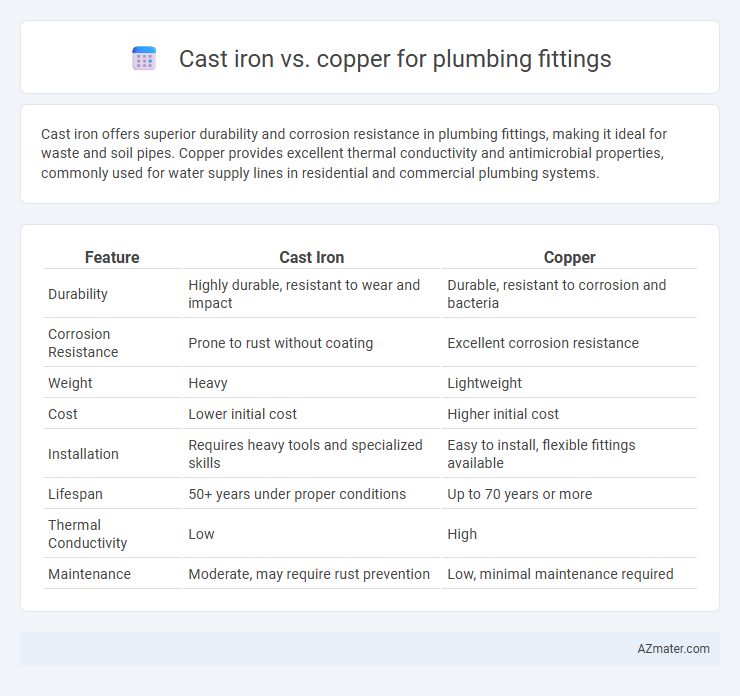Cast iron offers superior durability and corrosion resistance in plumbing fittings, making it ideal for waste and soil pipes. Copper provides excellent thermal conductivity and antimicrobial properties, commonly used for water supply lines in residential and commercial plumbing systems.
Table of Comparison
| Feature | Cast Iron | Copper |
|---|---|---|
| Durability | Highly durable, resistant to wear and impact | Durable, resistant to corrosion and bacteria |
| Corrosion Resistance | Prone to rust without coating | Excellent corrosion resistance |
| Weight | Heavy | Lightweight |
| Cost | Lower initial cost | Higher initial cost |
| Installation | Requires heavy tools and specialized skills | Easy to install, flexible fittings available |
| Lifespan | 50+ years under proper conditions | Up to 70 years or more |
| Thermal Conductivity | Low | High |
| Maintenance | Moderate, may require rust prevention | Low, minimal maintenance required |
Introduction to Cast Iron and Copper Plumbing Fittings
Cast iron plumbing fittings offer exceptional durability and corrosion resistance, making them ideal for drainage and sewer systems where strength and longevity are critical. Copper fittings, valued for their excellent thermal conductivity and antimicrobial properties, are commonly used in potable water supply lines and heating systems. Both materials provide reliable performance, but their distinct physical and chemical characteristics suit different plumbing applications.
Material Properties: Cast Iron vs. Copper
Cast iron offers high durability, excellent noise dampening, and resistance to corrosion but is heavier and more brittle compared to copper. Copper provides superior flexibility, natural antimicrobial properties, and resistance to high temperatures and pressures, making it ideal for potable water systems. Both materials have specific advantages depending on plumbing application requirements, with copper favoring residential hot and cold water supply lines and cast iron preferred for drainage and sewer lines due to its strength and longevity.
Durability and Longevity Comparison
Cast iron plumbing fittings offer superior durability due to their resistance to corrosion, high pressure, and temperature fluctuations, making them suitable for heavy-duty applications. Copper fittings excel in longevity as they are highly resistant to rust and biofilm build-up, ensuring clean water flow and reducing the risk of leaks over time. Both materials provide excellent lifespan, but cast iron typically wears better under mechanical stress, while copper performs better in preventing microbial contamination.
Corrosion Resistance and Maintenance
Cast iron plumbing fittings exhibit high corrosion resistance due to their thick protective oxide layer, making them durable in harsh environments with minimal maintenance required. Copper fittings offer excellent corrosion resistance as well, forming a natural patina that prevents rust and extends lifespan, but may require periodic inspection to avoid pinhole leaks caused by acidic water. Both materials provide long-term reliability, yet copper demands slightly more maintenance to ensure optimal performance in varying water conditions.
Installation Process and Ease
Cast iron plumbing fittings require heavy equipment and more labor-intensive installation due to their weight and rigidity, often involving cutting, welding, or special couplings. Copper fittings offer easier and faster installation with flexible soldering, push-fit, or compression methods, suitable for tight spaces and DIY projects. The ease of copper fittings reduces installation time and labor costs, while cast iron provides durability but demands specialized skills and tools.
Cost Analysis: Cast Iron vs. Copper
Cast iron plumbing fittings typically cost between $10 to $20 per fitting, offering durability and noise reduction benefits at a lower price point compared to copper. Copper fittings range from $15 to $30 per piece, reflecting higher material costs but providing corrosion resistance and easier installation. Considering long-term maintenance and lifespan, cast iron may present better cost-efficiency in high-pressure or noisy environments, while copper suits applications prioritizing corrosion resistance despite a higher initial investment.
Environmental Impact and Sustainability
Cast iron plumbing fittings offer enhanced sustainability due to their high recyclability and long lifespan, reducing landfill waste and minimizing resource extraction. Copper fittings, while also recyclable, involve energy-intensive mining and refining processes that contribute to higher carbon emissions. Choosing cast iron over copper can lower the environmental footprint in plumbing systems by prioritizing durability and resource efficiency.
Common Applications in Plumbing Systems
Cast iron plumbing fittings are commonly used in drainage and sewer systems due to their durability, noise-reducing properties, and resistance to corrosion and high temperatures. Copper fittings are preferred for water supply lines because of their excellent thermal conductivity, resistance to corrosion, and ease of installation in both hot and cold water systems. Both materials offer strong reliability but are selected based on specific plumbing needs such as waste disposal versus potable water delivery.
Safety and Health Considerations
Cast iron plumbing fittings offer superior resistance to bacterial growth and corrosion, reducing risks of water contamination and ensuring safer potable water systems. Copper fittings, while antimicrobial and resistant to biofilm formation, can sometimes leach trace amounts of copper into water, which may pose health risks if concentrations exceed safe levels. Proper installation, maintenance, and adherence to water quality standards are essential to maximizing health safety for both materials in plumbing applications.
Which is Better for Your Plumbing Needs?
Cast iron offers superior durability and noise reduction, making it ideal for drain and waste systems, while copper excels in water supply lines due to its corrosion resistance and ease of installation. Copper's antimicrobial properties and lightweight nature provide efficient performance and longevity, though it comes at a higher material cost compared to cast iron. Choosing between cast iron and copper depends on specific plumbing requirements, budget constraints, and the desired lifespan of the plumbing system.

Infographic: Cast iron vs Copper for Plumbing fitting
 azmater.com
azmater.com